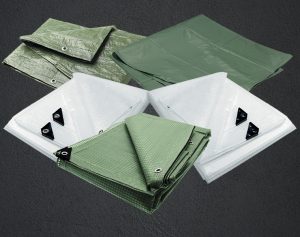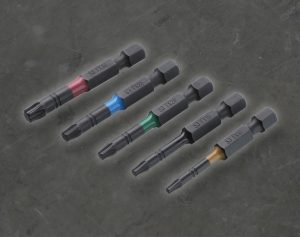Tarpaulins
There are basically three different types of tarpaulins; Canvas, Poly Ethylene (PE) and Poly Vinyl Chloride (PVC). Canvas tarps are very heavy and are not waterproof or resistant to rot/fungus, and as such they are almost never used in construction anymore.
PE or PVC?
Both the PE and the PVC tarps are waterproof, resistant to rot and fungus, and often also comes with a high tear strength. This makes both types of tarps suitable for most covering and protections needs within the building- and similar – industries.
Both PE and PVC tarpaulins are produced by a process of weaving to create a sheet of tarp that are laminated.
As a general rule of thumb, PE tarps are lighter and cheaper than PVC, so PE are often chosen for basic covering tasks.
The PVC tarps are very strong, and are often used for more demanding tasks within the industry and also often for covering roofs.
Choose the right quality
The weight of the tarpaulin are often measured in gram per squaremeter (g/m2 or gsm). Unfortunately, many people believe, that the weight of the tarpaulin can be used as a direct indicator for the quality – but this is often not the truth.
Some factories are achieving higher weights by weaving different reused plastic materials into the tarpaulins, resulting in only a heavier but not stronger tarpaulin.
The weight of the tarpaulin can only be used as an indicator of quality of the tarpaulin sheets when the comparing tarps are made from the same factory. When comparing tarps from different manufacturers, factors such as the quality of the weaving (the mesh count), thickness (mil) and the quality of the lamination should also be accounted for.
Besides the quality of the tarp sheet, most tarpaulins also have additional features to enhance their strength and durability, i.e. wire mesh, reinforced edges and corners, different types of eyelets and so on.
Features
Wire mesh: A mesh of thin wires, placed between the weaved tarpaulin sheet and the lamination. The wire mesh significantly enhances the strength of the tarpaulins.
See all STACO tarpaulins with wire mesh here.
Reinforced edges: A string sown into the edge of the tarpaulin. The string enhances the strength of the edge of the tarpaulin, making it more resistant to tearing.
Corner reinforcement: Tarpaulins are often most exposed in the corners, where they are often affected from two sides. Several tarpaulins feature corner reinforcements in rubber og plastic around the eyelet in the corner, to enhance the tear strength.
Eyelets: Many tarpaulins have eyelets in aluminum, typically every meter on all sides. Tarpaulins designed for extra demanding tasks, often have eyelets made of rubber. The rubber eyelets are more flexible and will give in rather than tear when exposed to high pressure.
Environment:
Tarpaulins are manufactured all over the world, sometimes regrettably under circumstances that can be harmful to the environment. To ensure protection of both health and environment, it is important to make sure, that the tarpaulins fulfil the demands of the REACH-regulation.
The REACH-regulation are a regulation under the EU, that ensures, that products being sold within the EU does not contain high amounts of dangerous substances.
All STACO tarpaulins are of course manufactured within the boundaries of the REACH-regulation.



